
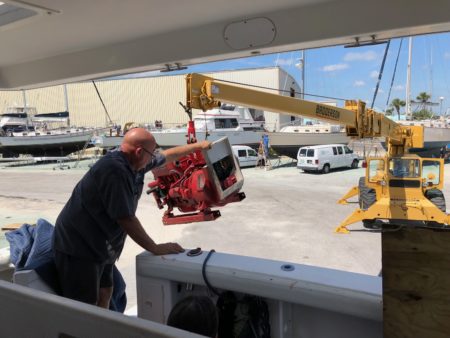
Our Bayliner 4788 came originally equipped with a hefty Westerbeke 12.5KW diesel generator.
Like most stock boat and RV generators – it was sized so that absolutely everything on board could be turned on at once, giving people a “just like home” electrical experience.
This means that you could crank up all three air conditioners, the water heater, the microwave, the stove, the washing machine, the central vacuum, and even have a few guests blowdrying their hair – all without an overload.
But this also means that most of the time, the generator is actually significantly underloaded.
If you have the presence of mind to manage your usage and not try to run everything at once – it is better to have a generator sized for your average load, not for your peak load.
A generator is happier and more efficient being run with the load it was designed for, and a right-sized generator will be smaller, lighter, and cheaper than a peak-load monster.
Under our more common usage scenarios all our generator needs to power regularly is the battery charger, fridge, freezer, an AC on a hot day, our computers, our new 49″ TV occasionally and/or a cooking appliance or two. And for those special occasions where more power is needed temporarily, a boosting inverter can provide extra AC power by tapping into the batteries.
In other words – if we were designing our boat from scratch, we’d prefer a small generator to a big one.
But since we already had a generator on our boat (and we haven’t upgraded the inverter yet)… if it ain’t broke, don’t fix it. Right?
Unfortunately – our big old Westerbeke just wasn’t making things easy for us.
Problems With The Old Generator
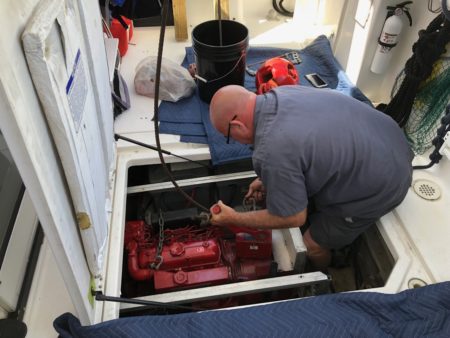
When we purchased our boat, the Westerbeke had just 1,421.4 hours logged on it.
This is actually a worryingly low number for a 20 year old generator, because diesel engines like to be run – and this one clearly had not been.
But the generator did pass survey, with the only significant issue being voltage sag under high load. But if we treated it like a smaller generaor and didn’t try to use all three AC’s at once, it was performing fine.
Initially anyway.
The first time the generator really let us down was when we cruised up from Ft Myers to try the W. P. Franklin Locks for the first time. While sitting enjoying lunch after doing the locks, the generator browned-out, then revved back up – repeatedly.
We quickly shut things down, cruised home without AC, dug deep troubleshooting, and could not isolate any problem.
We ran into similar occasional brownouts a few times while anchoring out during our amazing transit down the Everglades last summer, and sometimes the generator would stall completely.
It would always restart easily, but we just couldn’t trust it.
We suspected fuel issues, sensor issues, or heat issues – and we consulted with several experts. But every time we thought we found and fixed a problem, the mysterious brownouts would eventually return.
Frustrating – but we had been learning to live with needing to restart the generator regularly to get through the day.
Until…
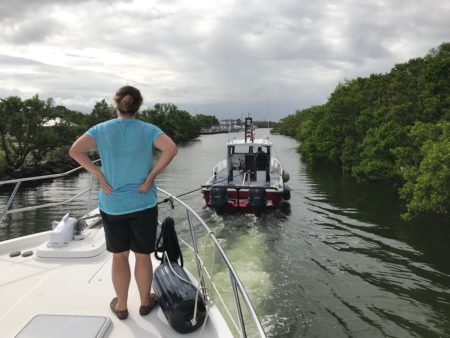
The morning of November 2, 2017 the generator stalled again, but it would not restart with any of our usual tricks.
This sudden lack of any way to charge our batteries lead to us canceling our extended anchoring out plans and scrambling to get to a marina … when we ended up hitting a bump in the water.
The dead generator was just the start of a very bad day.
While the boat was being repaired in Miami, we sought help from a mechanic in finding what was keeping the generator from restarting. It turned out to be a stuck solenoid.
With a bit of percussive maintenance we learned how to restart the engine from this type of stall – but we were still at a loss as to the bigger problem, and so was the mechanic
Our issues continued and got progressively more common as we continued up the coast this spring, turning anchoring out into a frustrating ordeal. We were troubleshooting more than enjoying our stops.
When we reached Fort Pierce, we were referred to a mechanic by Ask Captain Chris to help us hopefully find the problem once and for all.
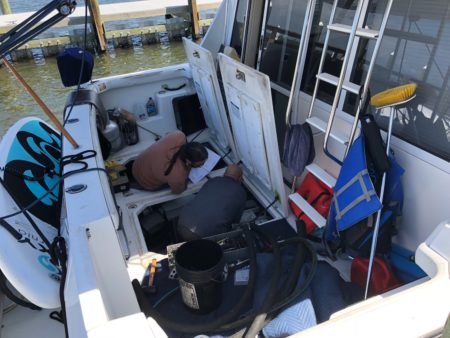
But his conclusion after some troubleshooting was that there probably wasn’t just one single problem. We did some further troubleshooting of likely culprits, to no avail. It was obviously going to be an ongoing frustrating & costly game of whack-a-mole to find and fix all the potential issues.
And, all the rubber hoses in the generator were crumbling and some had split in the process of disassembly for diagnostics. So to even get back to where we had been would be an expensive chore.
Before proceeding, his suggestion – bite the bullet and replace it.
We realized we could probably get it working reliably again, eventually. But why keep investing in something that we didn’t really want anyway? And just how long would it take to get to reliable?
Why not get a generator that we would have designed into our boat from the beginning, if given the choice?
When we reached this decision, the generator had 1,635.5 hours on it. After 200 hours of frustration, dealing with for nearly a year and a lot of planned anchoring out in our future – we were ready for something reliable we could trust in.
Our Pick for an Upgrade: Northern Lights M673L3
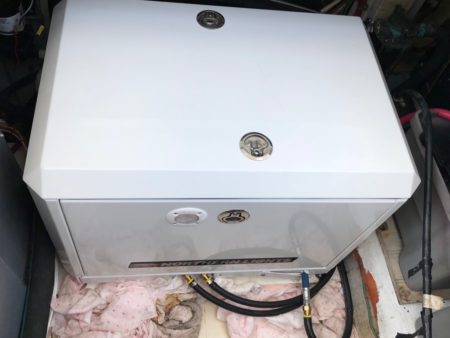
We had to come up with a plan fast, since the troubleshooting process had burned through two weeks and had left us with a completely non-functional and partially disassembled generator.
What should we get to replace our Westerbeke, and could we get it in time to tackle this project while we were still docked in Fort Pierce, FL for a month?
We dove into researching options – trying to find the ideally sized generator, and researching brands and models.
Size was easy – a bit of math narrowed in that a 5-8KW generator would be just about perfect for our typical loads, and that would pair nicely with our eventual plan for a Victron Quattro inverter and lithium batteries.
The generator and inverter would be able to combine forces to let us use our electrical system without any limitations or stress about what is turned on/off – just like we have grown used to on our bus.
But what brand generator?
In researching – the one brand I found that had a universally great reputation for quality and reliability was Northern Lights, with the only complaint being that the generators were more expensive than their competitors.
Major brands Cummins Onan and Kohler also had good reputations, but a lot of people complained about their electronic brains that were expensive to service, and which were not as conducive to self maintenance and troubleshooting.
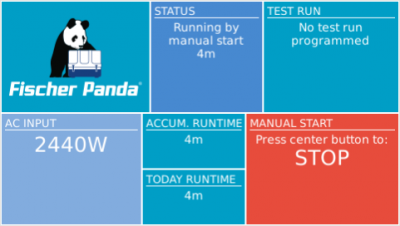
Next on my list was Fischer Panda, which intrigued me because there was a way to integrate in with a Victron CCGX control panel, and their generators were tiny, quiet, and extremely high-tech. But online forums were filled with stories of Panda generator failures, and people saying that you really needed to treat Fischer Panda generators with extreme TLC to keep them running well over time. And though the Victron integration was geeky cool, Fischer Panda USA told me they had no intention to ever officially support this and I would have to get parts and deal directly with Europe if I wanted that feature. *ugh*
Our mechanic Eddie was a big fan of Phasor Marine (and a dealer for them – but made it clear he’d work with us no matter what we selected), and though I was turned off by the sparse Phasor website and lack of technical details and documentation published online – digging deeper in forums revealed that Phasor had a really solid reputation for building bulletproof generators that were cheaper than many of the better known brands. But since they were built to order, it would likely mean needing to push out our schedule to get one.
But Phasor was definitely a top contender – and we were on the verge of ordering one.
But when I started calling around for pricing and shipping estimates to see what else might fit our schedule, I discovered Citimarine Store in Miami who said they had Northern Lights generators available for immediate shipment, and they quoted me a price (with sound shield) that was not all the much more than we had been quoted for a Phasor. Wow!
But just as we were about to wire Citimarine the money, they let us know there had been a problem – they had accidentally quoted us an international price and they could not honor it. When I expressed my disappointment, they said it was their mistake and they would try to make it right and to stand by.
An hour later – our Citimarine sales rep had managed to find us a different Northern Lights dealer Mavex (a friendly local competitor) who was somehow able to honor the original quoted price.
It ended up being a very weird roller coaster – but in the end I was impressed by the customer service from both companies, and we ended up with a 6KW Northern Lights M673L3 on a truck headed our way just a day later.
Great brand, the perfectly sized generator, a good price, and delivery on time. Score!
Now we just needed to get it installed…
The Generator Removal & Installation
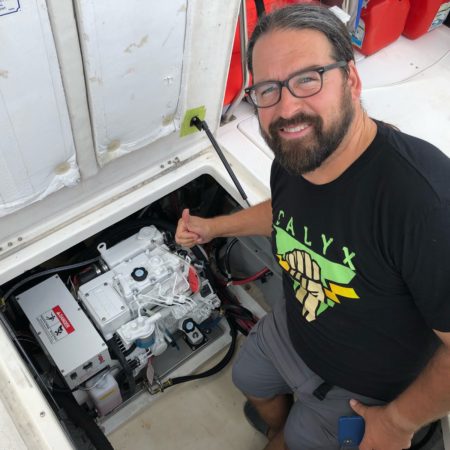
The Northern Light M673L3 is half the size and half the weight of our old Westerbeke, and after spending some time crawling around with a tape measure I was able to determine that it would be theoretically possible to install the new generator rotated 90 degrees relative to the old one, freeing up a ton of potential storage space in the process.
But it would be VERY tight – particularly once the sound shield was installed.
Complicating things – the Northern Lights sound shield had just been redesigned, and the new design was backordered.
So we would have to install the generator, and then add the sound shield later. Or skip the sound shield entirely.
We didn’t want to wait in Fort Pierce any longer, so we pressed ahead with the generator install.
Installing a new generator on a boat is not as easy (or cheap!) as in was on our RV – which can be done usually with a folk lift.
Here are the key steps in the project:
-
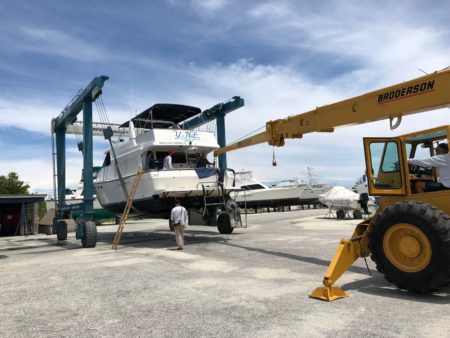
Removal and placement pretty much both looked like this. Removal Prep Work: Once we decided to go with replace rather than repair, our mechanic Eddie came over and spent an afternoon disconnecting the old generator so that we could make efficient use of time at the boatyard.
- Removal Day: Cracker Boys is a DIY boatyard in Fort Pierce and a well oiled machine, and massive contrast to our yard experience in Miami. They had us in the air minutes after we arrived, and though it took some masterful crane maneuvering to get under our flybridge they had the old generator out and on the ground before our hull had even had a chance to dry. We were back in the water in no time (after a pressure wash and quick hull inspection)!
-
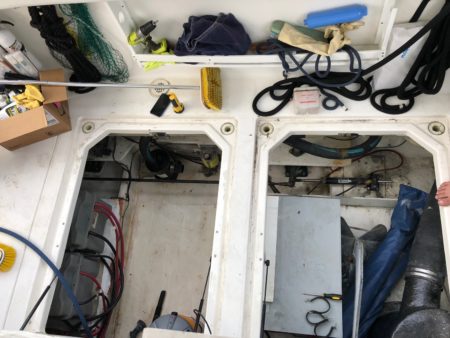
Getting ready for installation. Clean-Up & Prep Work: We didn’t know what sort of mess we would find under the old generator – which is why we didn’t plan to bring the new generator in on this haul out. But though the plywood base of the old generator was rotted away we were pleased to discover the fiberglass underneath was in great shape and all we needed was a lot of cleanup. Cherie and I handled getting the lazarette ready, removing twenty years of gunk and yards of cracked old hoses. Meanwhile – Eddie crafted a new mounting base out of marine plywood.
- Back to the Boatyard: It took a while for the weather and the boatyards availability to line up, but when we had a window we cruised back to Cracker Boy’s and repeated the same process – only this time we used the crane to bring the new generator on board.
- Initial Installation: It took Eddie two visits to our boat to get the generator hooked up, in particular since he had to have an adapter fabricated to mate the differing exhaust hose sizes. I apprenticed on every step, since I knew it would be up to me to tackle the sound shield.
-
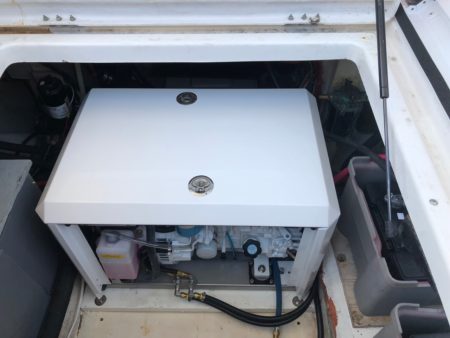
The 90-degree fuel line fittings shown here wouldn’t work with the design of the sound shield. I had to ride my bike all over New Smyrna Beach to find a hydraulic supply shop with 45-degree alternatives. Sound Shield Installation: The Northern Lights GEM sound shield had been backordered, and we considered going without and having that portion of our generator purchase refunded. But after our first days anchored out without it, we really knew we wanted to invest in getting even quieter.
The sound shield finally caught up with us in New Smyrna Beach, and one of the body panels had been damaged in shipping. Installing it actually proved to be more challenging than I had imagined, since I actually needed to shift the generator sideways by several inches to get everything to fit.
Disconnecting the generator, moving it, installing the sound shield, and then reconnecting everything was a pretty intense multi-day challenge – but we managed to do it on our own without needing any outside help.
Yay us!
Here is a video detailing the entire generator swap project:
And as a special treat, our friend Captain Chris met us at the boatyard to film the generator removal. He gave us permission to share his play-by-play commentary of the old generator’s removal. It may sound boring to watch twenty minutes of boatyard lift and crane work, but his narration makes it as riveting as watching a professional baseball playoff game with expert color commentary:
Enjoy!
How Is The New Generator Working Out?
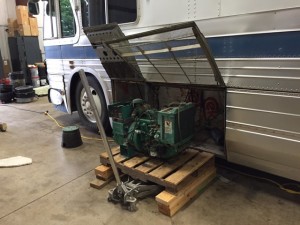
We’ve just reached the 100 hour mark on the new generator, which means that it is time for our second oil change and the official end of the break-in period.
And so far, the generator has been mostly great.
We’ve been impressed that the generator has no problem starting loads with substantial surge currents, like our AC units. We can easily run two AC’s at once, and were surprised to be able to even run all three at the same time (with nothing else).
We will eventually add a soft-start on all of our AC units to make these loads even easier to manage.
Overall the new generator without a sound shield is quieter than the old one with, and now that we have the sound shield on the generator can barely be heard over the sound of the salon AC, and overall it is a pretty quiet background noise that is usually easy to forget.
We’re still tweaking a few things, but overall we are very happy with this project – and we hope that we have a generator that we can rely on for years to come.
Yay!
And The Costs?
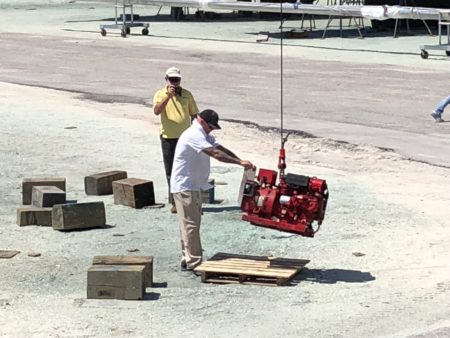
Everyone always wants to know how much various boat projects cost, so here it is…
- Northern Lights M673L3 generator and “new design” GEM sound shield – $12,200
- Installation by Eddie at Southeast Power Systems, including labor and lots of misc parts and hoses – $3,000
- Two Haulouts at Cracker Boys – $720
Roughly $16 boat bucks* overall – a pretty hefty hit to our boat upgrade budget.
But if this proves to be as reliable and long lasting as we hope, we consider it a very worthwhile investment in our boat.
And being able to trust that we have reliable power to let us stay out at anchor or on mooring balls will save us substantially over time too compared to transient marina fees, making the hit not nearly so painful.
So far, no regrets at all!
Now.. to get that boosting inverter and lithium batteries. That may have to wait until our next cruising season for the stars to align with finding a canvas maker, solar install assistance, shipping availability and replenishing the budget.
Further Reading:
One Boat Buck = $1000, it’s just more palatable to say ’16 boat bucks’ ;). Oh, and while it’s common to say BOAT = Break Out Another Thousand, we’ve found this totally NOT true.
We think Break Out Another TEN Thousand is far more accurate.

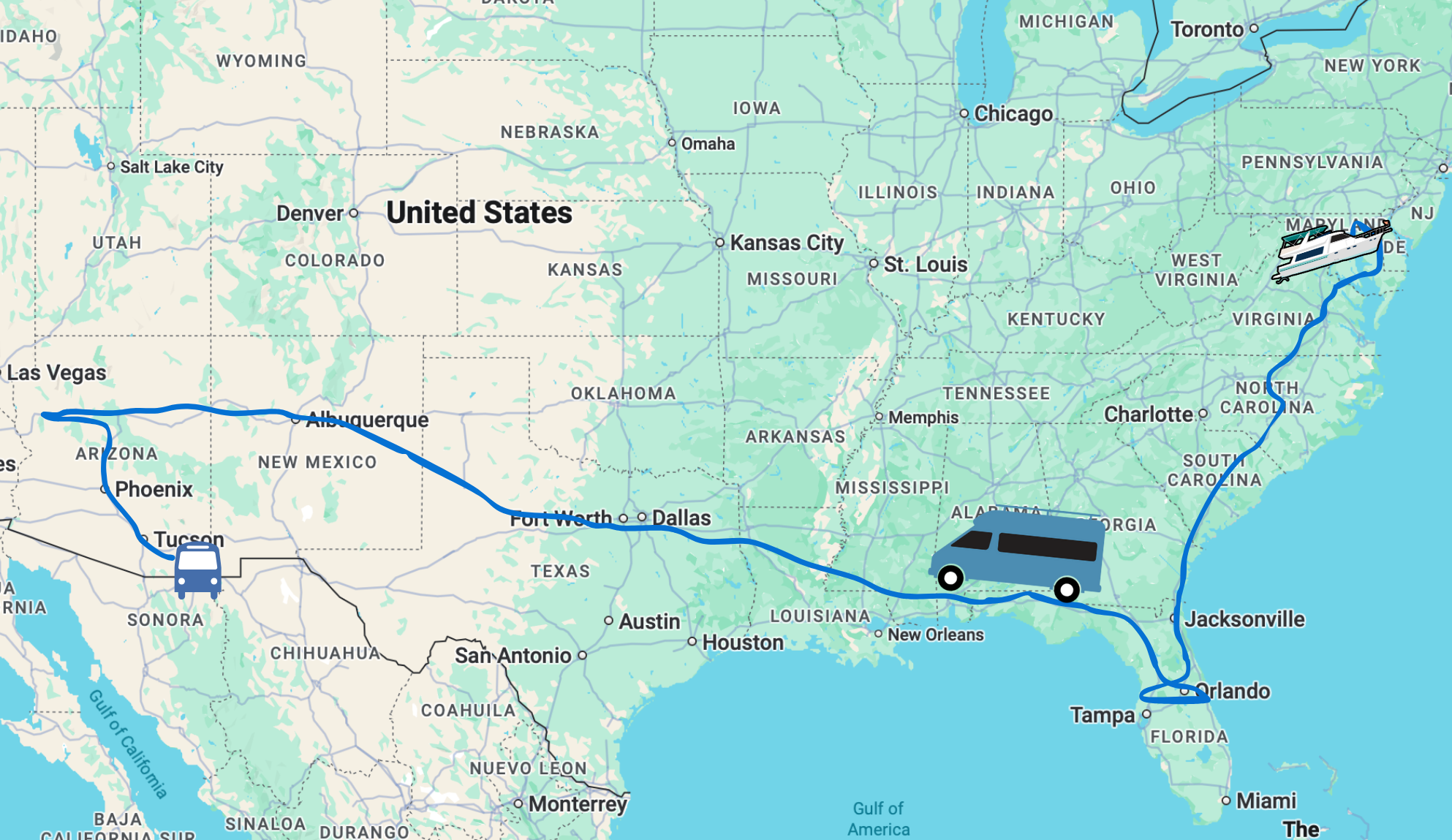
Congratulations on the new generator – you made the right choice, IMHO. No better generators than NL! We have had NL gensets on our last 3 boats and all have performed flawlessly. Just make sure to warm up and cool down the genny without load for a couple of minutes and try and maintain at least 50 – 60% load while running and they will go for ever with regular oil changes and the recommended preventative maintenance. NL also has the best after-sales assistance should you ever have any issues.
Great upgrade project and a nice write up. Also enjoyed the videos.
Great writeup! I have a 2001 4788 with about 1800 hours on the Westerbeke 12.5. Not sure I’d go with a 6kW replacement as we need lots of AC on the gulf coast. But Northern Lights makes a 9kW version that could work for me if/when my Westerbeke decides to quit. Thanks again!
We’re cruising Florida right now… the 6KW is running 2 ACs during the heat of the day without problem.
Chris,
Did you consider a DC generator while you were doing your research?
It has become my understanding over the past few years that small diesel engines do not have the light-loading problems found in large hp diesel engines run at light loads. I understand the concern with 1400 hours over 2 years, but in a 12kW class engine (maybe 25 hP), I wonder if you could comment more on the light-loading issue. You’re in the range of an auxiliary engine on many 30′ – 40′ sailboats, and they don’t get much use or heavy loading.
Thanks for sharing!
Jim Healy
I’ve contemplated a DC generator off and on over the years – particularly when we were planning our bus generator upgrade project. There are certainly advantages when it comes to fast and efficient battery charging.
The downsides of a DC generator:
+ You need to have an appropriate inverter system and batteries installed to take advantage of it. We weren’t ready to tackle the lithium and inverter upgrade project just yet, and so this meant a DC generator was not an option at all.
+ The inverter is the source of all your AC power, and if it fails you are hosed. With an AC generator, you have a backup.
+ The inverter needs to be able to handle your peak loads – which would require two Victron Quattros in parallel for us. An AC generator on the other hand would only require a single Quattro for our loads and planned usage.
+ There just are not as many DC generator options available.
On our bus, I could not find any DC generator that would physically fit in the spare-tire bay that I was wanting to use for the generator – so that is what lead us to the small propane Onan.
On the boat – the reasons listed above more than overwhelm the potential positives.
Cheers,
– Chris
Understand.
There’s a guy out there selling a brand called ZRD. I’ve talked with him at boat shows. He’s not very willing to talk about his device’s specs, but he uses a heavy duty truck alternator and a Balmar external regulator, so easy to replace. Most of what he makes is custom brackets and mounting hdwr. Easy enuf to make up as a DIY project.
I was contemplating a DC genset with a 2kW inverter for our house loads (exists today) and a 4kW inverter for the heat pumps. You’re right that if an inverter failed, I’d be down, but same is true of AC genset (except backup for battery charging would be on-engine alternator). And, I think an inverter might be easier – both availability and ease-of-installation – to replace. That, I can do myself w/o hauling out. Genset is much more of a project!
Maybe when my circa-1975 old-iron Onan dies…
Again, great article. Thanks for sharing!
Jim
When you decide to sell this boat sometime in the future, it will be a fantastic buy! Thanks for sharing all of this with us. Great fun!
Fantastic video of your generator upgrade! Love your videos.